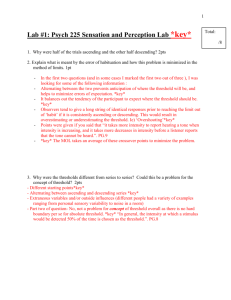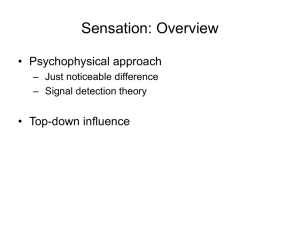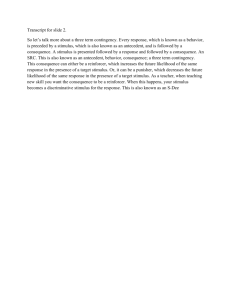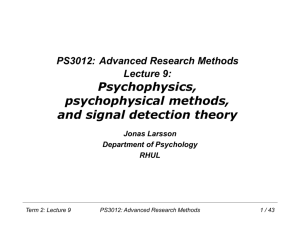Introduction to psychophysics
advertisement
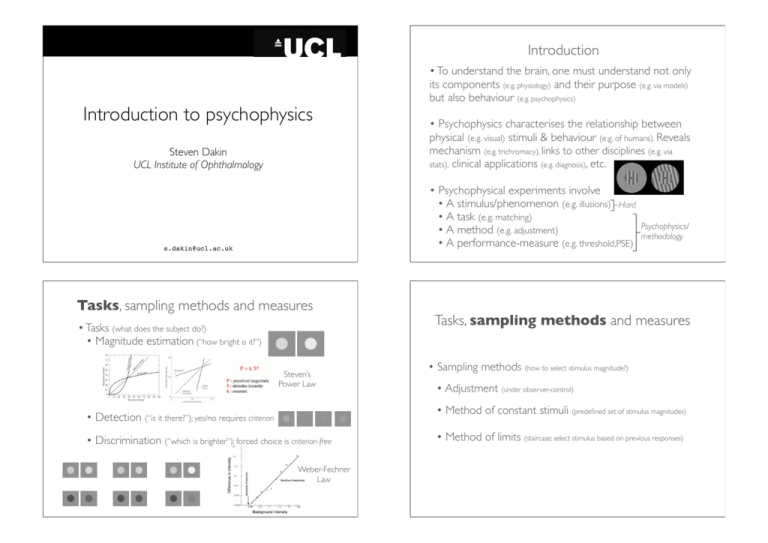
Introduction
Introduction to psychophysics
Steven Dakin
UCL Institute of Ophthalmology
• To understand the brain, one must understand not only
its components (e.g. physiology) and their purpose (e.g. via models)
but also behaviour (e.g. psychophysics)
• Psychophysics characterises the relationship between
physical (e.g. visual) stimuli & behaviour (e.g. of humans). Reveals
mechanism (e.g. trichromacy), links to other disciplines (e.g. via
stats), clinical applications (e.g. diagnosis), etc.
• Psychophysical experiments involve
• A stimulus/phenomenon (e.g. illusions) Hard
• A task (e.g. matching)
• A method (e.g. adjustment)
• A performance-measure (e.g. threshold,PSE)
s.dakin@ucl.ac.uk
Tasks, sampling methods and measures
• Tasks (what does the subject do?)
• Magnitude estimation (“how bright is it?”)
Steven’s
Power Law
Psychophysics/
methodology
Tasks, sampling methods and measures
• Sampling methods (how to select stimulus magnitude?)
• Adjustment (under observer-control)
• Method of constant stimuli (predefined set of stimulus magnitudes)
• Detection (“is it there?”); yes/no requires criterion
• Discrimination (“which is brighter”); forced choice is criterion-free
Weber-Fechner
Law
• Method of limits (staircase; select stimulus based on previous responses)
Example I: Acuity
Tasks, sampling methods and measures
• Task (letter
• Stimulus
identification;
10 alternatives)
(letter)
• Measures: (how to characterise behaviour?)
• Reaction times (how long to judge?). Atheoretical, but popular (e.g. IAT)
• Percent correct (what level of performance at a fixed stimulus magnitude?): e.g.
observers memorise 10 objects & are presented with a new set containing 5 they saw and 5
they hadn’t. Observer #1 recognises them all, observer #2 none; both score 50% correct...
• Method (adjustment)
• Point of subjective equality (stimulus mag. producing a perceptual match?)
• Thresholds (minimum stimulus mag. producing some level of performance?).
Performance
Absolute and relative...
• Principled (signal detection theory). • Reliable/replicable
• Efficient
• Versatile
Letter size
Appearance
• Performance
measure
[
(average setting = size
threshold)
Issues:
criterion,speed
1
2
3
Trial #
Example I: Acuity
Example I: Acuity
• Method (method of limits, adaptive, “3-down-1-up” staircase)
• Task(reading, 10AFC forced choice)
• Stimulus
(letter)
Letter size
Run
Correct
Trial
Incorrect
“B” !
“N” !
“O” "
...
• Method (method of constant stimuli) • Performance measure
• Performance
measure (threshold)
[
Acuity threshold:
Size leading to
79.2% correct
identification
5
(acuity threshold)
Letter size
1.0
Correct
Incorrect
Psychometric
function
10
Acuity/size
threshold
10
15
20
Trial #
Issues: efficiency/speed
0.1
20
25
30
35
40
45
Trial #
Issues: efficient but
demanding
0.55
5
15
(chart based)
Clinical visual acuity: 20/20
means we can read letters
20ft away, with line thickness
of 1.75mm (1 arc min.)
Psychometric functions for detection and discrimination
Example II: Contrast detection
C=ΔL/Lback
• Task (detection)
L
L back
• Performance measure
(absolute threshold)
Prop. correct
1.0
...
“Yes” !
“No” !
“No” "
• Method (method of constant stimuli)
!16 trials
!16 trials
!16 trials
Psychometric
function
0.5
Better
Worse
0.75
0.5
1.0
0.0
1.0
0.83
0.5
0.5
∝
Slope
1/threshold
slope=
threshold
Shift=bias or
appearance
0.0
threshold
1.0
PSE
threshold
#1
#2
0.75
Detection
threshold
0.5
...
0.0
1.0
Proportion
“2 “higher”
is higher”
Proportion
{
Stimulus contrast
Stimulus contrast
Proportion correct
ΔL
• Stimulus (disc)
0.0
0.1
0.2
Contrast
• Two key psychophysical measures
• Point of Subjective Equality (PSE) or bias measures appearance (accuracy)
• Threshold (here, increment threshold) measures limits* of performance (precision)
(*generally interested in best possible performance)
(Accuracy versus precision: an accurate but imprecise clock, on average yields the right time, but individual readings vary wildly.
An inaccurate but precise clock is e.g. reliably an hour slow)
• Experiment in which two or more alternatives are
present (e.g. “which side is patch on?”, “which is bigger?”)
• Some difference in convention as to whether both
alternatives must be present e.g. tilt. i.e. is it
the stimulus or the response?
• If it’s response; detection is forced choice
(actually 2AFC)
Type 1 and Type II tasks
• Type 1 tasks have a correct answer, Type II tasks do not. i.e. can
we provide feedback?
Prop. “1 brighter”
“Forced-choice” vs “Non-forced choice”
1.0
2AFC Matching task
1
0.5
0.0
2
“Criterion-free” vs “Criterion-dependent”
• Yes/no means observer judges how strong stimulus must
be to respond (“trigger happy”), forced choice does not
• Different criteria bias subjects in detection. (Bias still arises in
discrimination but is less problematic since less meaningful “trade-off ”...)
Physical Point of subjective
match
equality (PSE)
• Subtle: this experiment is about appearance (e.g. PSE, no feedback)
• Appearance: “apparent magnitude”, performance: can be “better”
• Above experiment measures both (slope/threshold & PSE/offset)...
Signal detection theory (SDT; Green & Swets, 1966)
• Trainee doctors ask “is a tumour present?” (“yes/no”, 50% present)
• How do we assess performance?
• Decisions limited by: information & criterion
Noise
• Uncertainty on such tasks arises from two types of noise
Response
Stimulus
“Yes”
“No”
Total
Present Hit, H (0.84)
Miss (0.16)
1.0
False alarm,
Correct
reject (0.50)
1.0
Absent
FA (0.50)
• ↑information
high H, low FA (↑sensitivity)
Stimulus
Response
Present
Absent
“Yes”
“No”
Total
Hit, H (0.5)
Miss (0.5)
1.0
False alarm,
Correct
reject (0.84)
FA (0.16)
Increasing external noise →
1.0
• Doctors weigh errors differently
• e.g. One considers missed diagnoses fatal,
• External noise: measurements, variation in lung tissue
• Assume doctor uses neural responses to detect tumour,
those responses are variable. This internal noise contributes
to an internal response
another minimises unnecessary procedures
• Not information but bias/
criterion that sets performance
noise
Could be firing rate
• Receiver operating curves (ROCs) plot a series of H/FA
measurements; show choices made by doctor
1.0
• Effects of criterion shift
d’=1.0
H=84%, FA=50%
d’=1.0
H=50%, FA=16%
• Doctors cannot set their criterion to achieve only hits and
no false alarms; noise overlap in prob. of occurrence curves internal response
on noise-alone must sometimes exceed signal+noise response
d’=2
d’=1
d’=0.5
d’=0
random
0.5
“Yes”
as
Hit rate (H)
Better
discrim.
Bi
• Base response on some minimum/criterion response
H=98%, FA=84%
→
Receiver operating curves & d’
Criterion
d’=1.0
Internal-response probability of
occurrence curves for noise
alone & signal+noise trials
“No”
d’=z(H)-z(F)
Note upward bowing
curves (typically H>FA)
d’=1.0,
lots of overlap
Low
med.
high
criteria
d’=2.0
less overlap
0.0
0.0
0.5
1.0
False
alarm
rate
(FA)
False
alarm
rate
(F)
• ↑ information (e.g. ↑signal)
Internal-response probability of
occurrence curves
noise
• for
Reducing
alone & signal+noise trials
better separation
noise improves performance too
• Good measure of information content of internal
representation is: d’=separation/spread
• ROC curves: practical & theoretical use
Psychometric functions & SDT
• d’=z(H)-z(FA) where z() is the inverse of the
cumulative Gaussian distribution
• Consider 2AFC orientation discrimination
σ
Prob
“CW”
Prob
“CW”
1.0
Summary & key points
Cumulative
Gaussian
function
0.5
Prob
“CW”
0.0
-3.0
0.0
• Means that essentially thresholds measure σ,
your uncertainty about a stimulus
• Weber’s law (thresholds rise as a proportion
of magnitude); SDT tells us variability rises
• Neurons exhibit multiplicative noise; the more
active, the more variable
Kingdom & Prins (2010)
Psychophysics: A Practical
Introduction. Academic
Press, London.
Class A versus Class B tasks
• How directly does a measurement relate a perceptual state
relate to a neural process? (Brindley, 1970)
• Class A: Physically different stimuli are indistinguishable
(identical appearance identical neural responses)
• Class B: Everything else
Adjust
Adjust
A
B
Adjust
e.g. metamers, detection...
3.0
• Psychophysics maps physical world to behaviour
(and perceptual representation)
• Tasks, methods & measures...
• Psychometric functions, thresholds & PSE
• Type of experiment (Type 1/2, criterion, forced-choice?)
• Signal detection theory (d’) and notion of response
variability
e.g. magnitude
estimation, appearance



